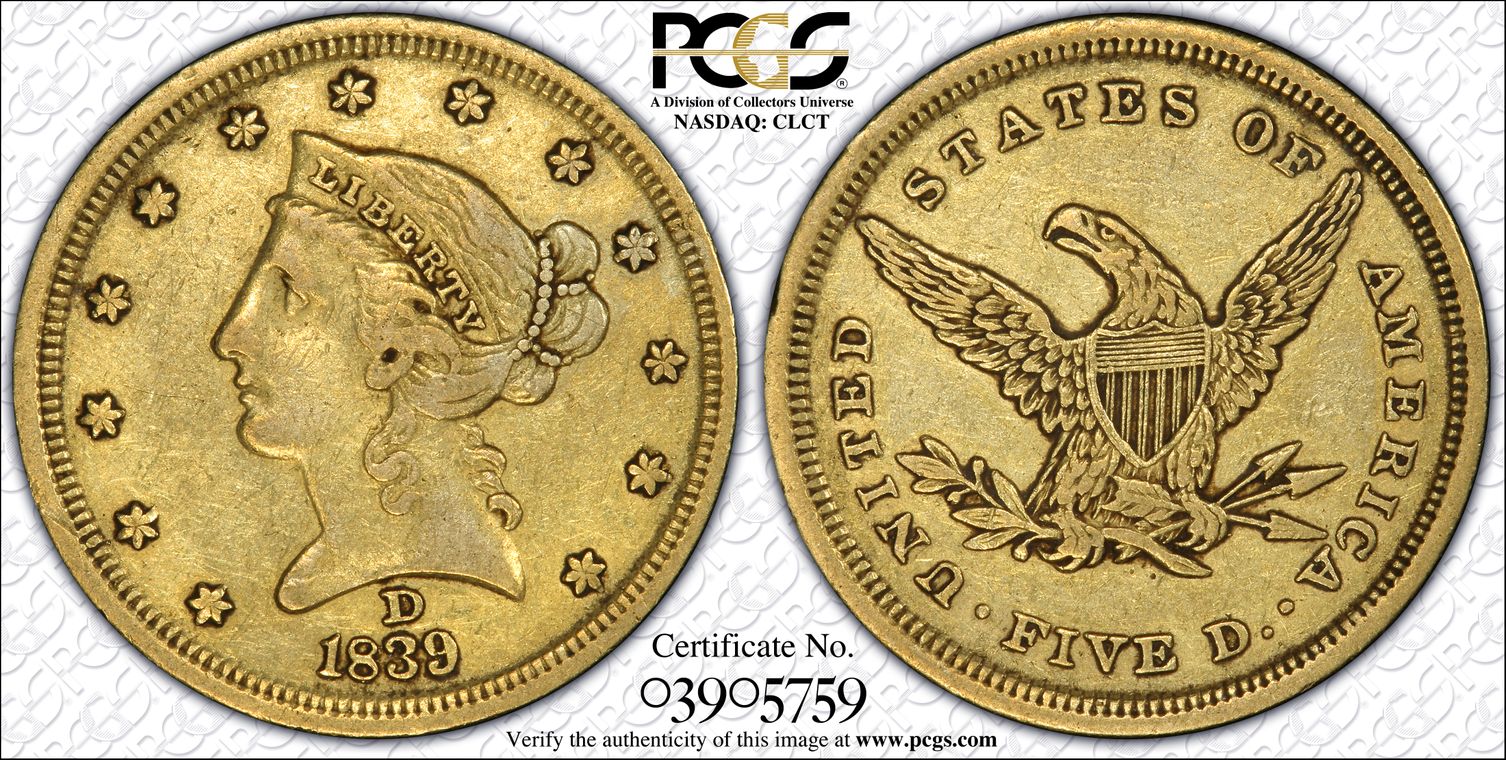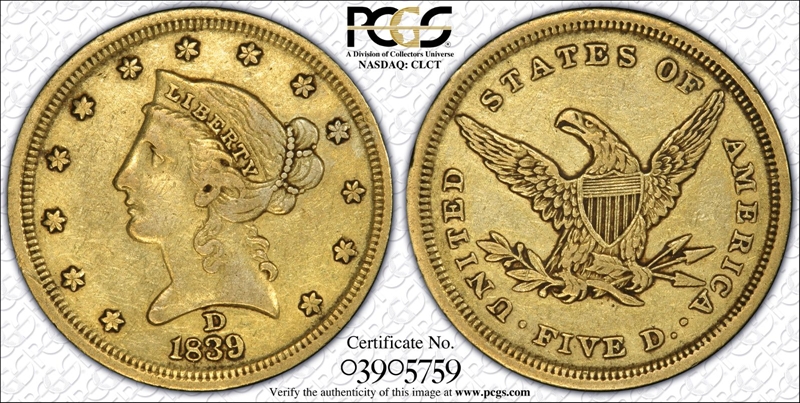1839-D $5 XF40 认证号03905759, PCGS号8193
拥有者评论
This one year Dahlonega type is the scarce 1-A variety. This variety is identified by the "D" mint mark directly above the "3" in 1839. This piece is crusty and gold toned with only slight rub on the high points.
专家评论
Doug Winter
The 1839-D is a very important and distinct one year type coin. After Mint Engraver William Kneass was incapacitated in 1838, he was replaced by Christian Gobrecht. The new design for the three circulating gold coins of this era can be first seen on the 1838 eagle and, in 1839, on the quarter eagle and half eagle.The Liberty head motif on the 1839-D half eagle is significantly different from that found on the 1840-1861 issues. On the 1839-D, the neck truncation is distinctly curved and it is positioned so that the back of the right side is far from the thirteenth star. On the redesigned head of 1840, the neck truncation is less curved and the back of the neck is closer to the thirteenth star. In addition, the top of Liberty’s bun is closer to the tenth star on the 1840-D than it is on the 1839-D. Most importantly, the mintmark is found on the obverse as on the 1838-D; beginning in 1840, it is found on the reverse.
The 1839-D half eagle is most often seen in Very Fine to Extremely Fine grades. It is quite rare in About Uncirculated-50 and it is very rare in the higher About Uncirculated grades. Mint State 1839-D half eagles are extremely rare.
STRIKE: The quality of strike differs greatly from coin to coin. There are two varieties known and one of these is typically weakly struck while the other usually shows a sharper strike (see Die Varieties, below, for more information). Many 1839-D half eagles have weakness of strike on the hair near the ear of Liberty, the brow and the back of the bun. The reverse is always sharper than the obverse and it usually shows complete definition, even on the legs and claws of the eagle. Some are known which show a very sharp strike on both the obverse and the reverse and these are considered to be very desirable by specialists.
SURFACES: The quality of the planchets used to strike 1839-D half eagles was not very good. It is common to find examples with mint-made areas of roughness. This is especially true in the obverse fields which may have a pockmarked appearance. Many have liberally abraded surfaces but it is not impossible to locate a coin that does not show an abundance of marks. The E in LIBERTY is strongly doubled at its base and this serves as a good hallmark of authenticity.
LUSTER: The luster has a distinctive grainy appearance. This graininess is often more pronounced at the border than at the center.
COLORATION: On uncleaned pieces, the coloration ranges from deep green-gold to a rich yellow-golden hue. The coloration has a distinctive appearance which is considerably different from other Dahlonega half eagles of this era. Very few 1839-D half eagles are known with original coloration.
EYE APPEAL: High grade 1839-D half eagles can be among the prettiest of all Dahlonega coins. A small number of extremely pleasing pieces exist which show good luster, lovely coloration, relatively few marks and sharp strikes. However, the level of eye appeal for most examples is only average. The typical piece offered to collectors has concentrated marks including mint-made planchet flaws, poor luster and softness at the obverse center.
PERSONAL OBSERVATIONS: For collectors who like original coins, locating a truly choice 1839-D half eagle can prove to be very frustrating.
DIE VARIETIES: There are two die varieties known.
Variety 1-A: On this variety the mintmark is directly over the 3 in the date and it is centered between the neck and the top of the 3. This variety often shows weakness of strike at the center of the obverse.
This is the rarer of the two varieties by a fairly substantial margin.
Variety 2-A: On this variety the mintmark is over the 39 in the date and it is centered in the field with the left edge of the D over the center of the 3.
This is the more common of the two varieties.
David Akers (1975/88)
As a date, the 1839-D is only slightly less rare than the 1839-C and the 1838-C. It is more rare than the 1838-D in all grades and it is extremely rare in high grade. Virtually all known specimens are in the VF to EF range and the number of AU or Unc. examples in existence is very small. Like the 1839-C, this date is very popular with collectors because of its rarity, the fact it was struck at the Dahlonega Mint, and the obverse location of the mintmark.PCGS #
8193
设计师
Christian Gobrecht
边缘
Reeded
直径
22.50 毫米
重量
8.36 克
铸币数量
18939
金属成分
90% Gold, 10% Copper
更高评级数量
74
评级较低的钱币数量
60
地区
The United States of America
价格指南
PCGS 数量报告
拍卖 - PCGS 评级的
拍卖 - NGC 评级的
稀有性和存量估计 了解更多
| 所有评级 | 150 |
| 60或以上 | 7 |
| 65或以上 | 0 |
| 所有评级 | R-7.5 |
| 60或以上 | R-9.6 |
| 65或以上 | R-10.1 |
| 所有评级 | 49 / 112 TIE |
| 60或以上 | 44 / 112 TIE |
| 65或以上 | 1 / 112 |
| 所有评级 | 79 / 218 TIE |
| 60或以上 | 71 / 218 TIE |
| 65或以上 | 1 / 218 |
状况普查 了解更多
| #1 MS62 PCGS grade |
| #1 MS62 PCGS grade |
| #3 MS61 PCGS grade |
| #3 MS61 PCGS grade |
| #5 MS60 PCGS grade |





















